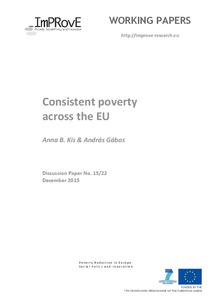Consistent poverty across the EU
"This paper investigates the relationship between material deprivation and relative income poverty. We apply the method suggested by Nolan and Whelan (2011a,b) to measure consistent poverty in the European Union. We are interested in the cross-country variation in those at risk of consistent po...
| Main Authors: | , , |
|---|---|
| Institution: | ETUI-European Trade Union Institute |
| Format: | TEXT |
| Language: | English |
| Published: |
Antwerp
2015
ImPRovE |
| Subjects: | |
| Online Access: | https://www.labourline.org/KENTIKA-19107129124919253019-Consistent-poverty-across-the-.htm |
| _version_ | 1771659896970805249 |
|---|---|
| author | ImPRovE, Antwerp Kis, Anna B. Gábos, András |
| author_facet | ImPRovE, Antwerp Kis, Anna B. Gábos, András |
| collection | Library items |
| description | "This paper investigates the relationship between material deprivation and relative income poverty. We apply the method suggested by Nolan and Whelan (2011a,b) to measure consistent poverty in the European Union. We are interested in the cross-country variation in those at risk of consistent poverty, as well as in the main household-level factors associated with this status. Using EU-SILC data from 2012, we first perform a correlation analysis to investigate the relationship between different poverty concepts and their measures. Second, we analyse the poverty identification patterns of the population by country and country group, according to the four possible combinations of income poverty and severe material deprivation status: not at risk at all, at risk of income poverty only, severely materially deprived only, at risk of consistent poverty. Third, multivariate regression analysis is performed to identify the main individual and household-level factors predicting consistent poverty status.According to our results, consistent poverty is present in all Member States, although its extent displays fairly large cross-country differences. The share of those living in consistent poverty is highest in the New Member States and the Southern countries. A higher rate of being generally at risk of poverty is associated with higher rates of consistent poverty across the countries. Living in consistent poverty (compared to not being at risk at all) is associated with several household characteristics not only in the EU as a whole, but also across country groups. Household structure, attained level of education of the household head, and work intensity of the household show the strongest correlation with consistent poverty status. Those living in consistent poverty are more likely than those in severe material deprivation or income poverty to live in bigger families, to have lower levels of education, and to have weak or non-existent links to the labour market. In addition, they evaluate their financial circumstances as being worse, ceteris paribus." |
| format | TEXT |
| geographic | EU countries |
| id | 19107129124919253019_b40487ddd97f4811a0cd460a5db58516 |
| institution | ETUI-European Trade Union Institute |
| is_hierarchy_id | 19107129124919253019_b40487ddd97f4811a0cd460a5db58516 |
| is_hierarchy_title | Consistent poverty across the EU |
| language | English |
| physical | 46 p. Digital |
| publishDate | 2015 |
| publisher | Antwerp ImPRovE |
| spellingShingle | ImPRovE, Antwerp Kis, Anna B. Gábos, András poverty social indicator statistics Consistent poverty across the EU |
| thumbnail | https://www.labourline.org/Image_prev.jpg?Archive=107240292542 |
| title | Consistent poverty across the EU |
| topic | poverty social indicator statistics |
| url | https://www.labourline.org/KENTIKA-19107129124919253019-Consistent-poverty-across-the-.htm |

